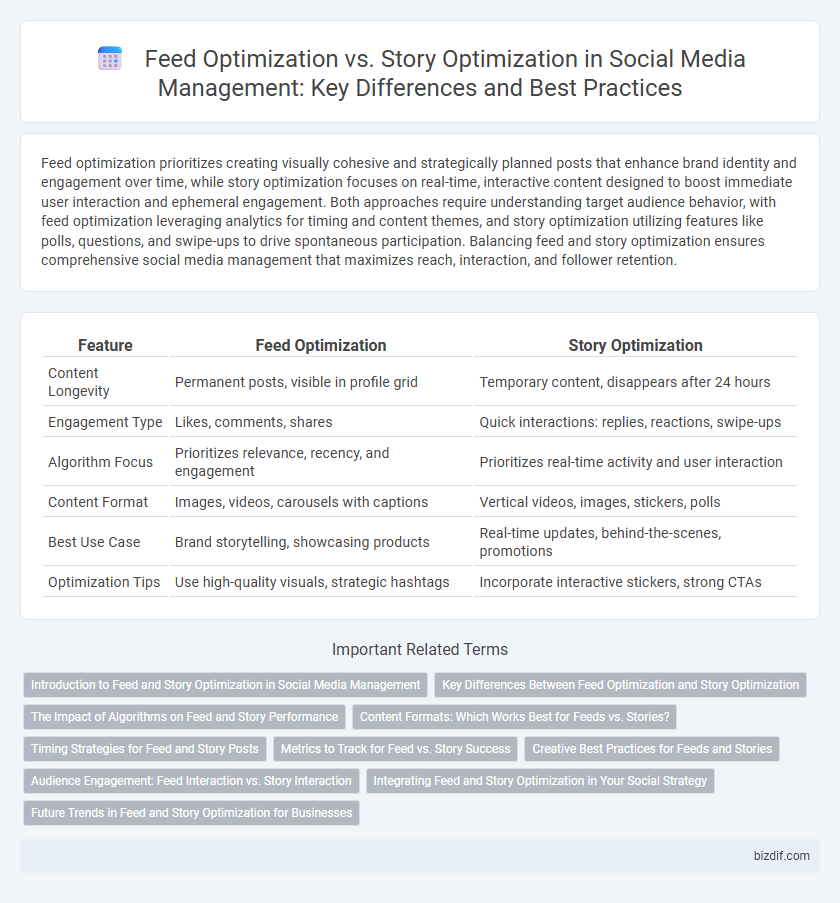Feed optimization prioritizes creating visually cohesive and strategically planned posts that enhance brand identity and engagement over time, while story optimization focuses on real-time, interactive content designed to boost immediate user interaction and ephemeral engagement. Both approaches require understanding target audience behavior, with feed optimization leveraging analytics for timing and content themes, and story optimization utilizing features like polls, questions, and swipe-ups to drive spontaneous participation. Balancing feed and story optimization ensures comprehensive social media management that maximizes reach, interaction, and follower retention.
Table of Comparison
| Feature | Feed Optimization | Story Optimization |
|---|---|---|
| Content Longevity | Permanent posts, visible in profile grid | Temporary content, disappears after 24 hours |
| Engagement Type | Likes, comments, shares | Quick interactions: replies, reactions, swipe-ups |
| Algorithm Focus | Prioritizes relevance, recency, and engagement | Prioritizes real-time activity and user interaction |
| Content Format | Images, videos, carousels with captions | Vertical videos, images, stickers, polls |
| Best Use Case | Brand storytelling, showcasing products | Real-time updates, behind-the-scenes, promotions |
| Optimization Tips | Use high-quality visuals, strategic hashtags | Incorporate interactive stickers, strong CTAs |
Introduction to Feed and Story Optimization in Social Media Management
Feed optimization in social media management focuses on enhancing the visual appeal, relevance, and engagement of posts within a user's main content stream, aiming to increase visibility and interaction through strategic use of keywords, hashtags, and compelling images or videos. Story optimization targets ephemeral content by crafting concise, engaging, and interactive narratives that leverage features like stickers, polls, and links to boost real-time engagement and brand storytelling. Both strategies require analyzing audience behavior and platform algorithms to maximize reach, engagement rates, and conversion potential through tailored content formats.
Key Differences Between Feed Optimization and Story Optimization
Feed optimization prioritizes static, high-quality images and videos designed to maintain a cohesive aesthetic and maximize engagement over time, leveraging SEO tactics like relevant hashtags and captions. Story optimization focuses on ephemeral, time-sensitive content with interactive elements such as polls, stickers, and swipe-up links to boost real-time engagement and direct user actions. The key difference lies in feed content aiming for longevity and discoverability, whereas stories emphasize immediacy and dynamic interaction.
The Impact of Algorithms on Feed and Story Performance
Algorithms prioritize engagement metrics differently for feed and story content, significantly influencing visibility and reach. Feed optimization focuses on maximizing likes, comments, and shares to boost algorithmic ranking, while story optimization targets quick interactions like replies and sticker taps for immediate user engagement. Understanding these distinct algorithmic behaviors enables marketers to tailor content strategies that enhance overall social media performance.
Content Formats: Which Works Best for Feeds vs. Stories?
Feed optimization favors high-quality images and videos with strong captions and relevant hashtags to enhance discoverability and engagement, while story optimization thrives on short, vertical videos, interactive polls, and swipe-up links that encourage immediate user interaction. Feeds benefit from evergreen content that maintains visibility over time, whereas stories prioritize ephemeral, real-time content designed for quick consumption and direct audience response. Brands should tailor formats by leveraging detailed visuals and hashtag strategies for feeds, contrasting with dynamic, interactive features for stories to maximize reach and engagement.
Timing Strategies for Feed and Story Posts
Timing strategies for feed posts prioritize peak engagement hours, typically mid-morning and early evening, to maximize visibility and interaction. Story posts benefit from more frequent updates throughout the day, leveraging moments when followers are actively browsing for real-time engagement. Analyzing platform-specific audience activity patterns ensures content reaches users when they are most receptive, enhancing overall social media performance.
Metrics to Track for Feed vs. Story Success
Feed optimization metrics prioritize engagement rate, reach, and saves to evaluate long-term content visibility and audience retention. Story optimization emphasizes completion rate, tap-forward and tap-back actions, and sticker interactions to gauge real-time viewer engagement and interest. Monitoring these distinct KPIs enables precise adjustment of content strategy to maximize platform-specific performance outcomes.
Creative Best Practices for Feeds and Stories
Creative best practices for feed optimization emphasize high-resolution visuals, concise captions with relevant keywords, and consistent branding to enhance engagement and discoverability. Story optimization focuses on vertical, full-screen content with interactive elements like polls, stickers, and swipe-up links to drive real-time interaction and deeper audience connection. Balancing feed's polished aesthetics with stories' authentic, spontaneous engagement ensures comprehensive social media management success.
Audience Engagement: Feed Interaction vs. Story Interaction
Feed optimization leverages algorithm-driven content placement to enhance audience engagement by maximizing likes, comments, and shares on posts that remain visible indefinitely. Story optimization focuses on ephemeral content designed to foster real-time interaction, such as direct messages, poll participation, and quick reactions, which tap into users' FOMO and prompt immediate responses. Understanding the distinct engagement patterns--persistent feed interactions versus transient story engagements--allows social media managers to tailor strategies for sustained visibility and agile, conversational audience connection.
Integrating Feed and Story Optimization in Your Social Strategy
Integrating feed and story optimization in your social media strategy enhances audience engagement by leveraging the unique strengths of both formats. Feed optimization focuses on crafting visually cohesive and rich content that remains discoverable and appealing over time, while story optimization emphasizes real-time interaction and ephemeral content that drives immediate user engagement. Balancing these approaches ensures a dynamic presence that maximizes reach, brand recall, and conversion rates across platforms like Instagram and Facebook.
Future Trends in Feed and Story Optimization for Businesses
Feed optimization increasingly leverages AI-driven personalization to deliver tailored content that maximizes engagement and conversion rates for businesses. Story optimization prioritizes interactive elements such as polls, AR filters, and shoppable tags to enhance real-time user participation and drive sales. Future trends indicate a convergence of these strategies, integrating advanced analytics and dynamic content to create seamless, immersive experiences across both feeds and stories.
Feed optimization vs Story optimization Infographic

 bizdif.com
bizdif.com